How to Install and Use DeepSeek R1: A Step-by-Step Guide
DeepSeek R1 is generating quite the buzz lately, and for good reason. This new open-source AI model is being compared to heavyweights like OpenAI o1 and Claude 3.5 Sonnet, especially in areas like math, coding, and reasoning tasks. What really sets DeepSeek R1 apart is that it runs locally on your own hardware—giving you total privacy and a 100% free alternative to cloud-based models.
If you’re curious about how DeepSeek R1 stacks up against OpenAI and Claude, just check out the discussions on Reddit. For me, it’s been a surprisingly good experience, especially considering it’s an entirely local setup.
But enough about the model—let’s get you set up! Here’s how I got DeepSeek R1 running on my machine. (No worries if you’re using Windows or Linux; these instructions work across platforms.)
Getting Started: Installing DeepSeek R1 Locally
Step 1: Install Ollama
First things first, you'll need to install Ollama, a tool designed to run AI models locally. Ollama makes it easy to download and execute models directly on your machine.
Note: Ollama supports different AI models, so it's a good tool to keep in your kit.
Step 2: Pull and Run DeepSeek R1
Once Ollama is installed, you’re ready to bring in the DeepSeek R1 model. There are different model sizes available, depending on your hardware capabilities:
- 1.5B Version (smallest):
ollama run deepseek-r1:1.5b - 8B Version (recommended starting point):
ollama run deepseek-r1:8b - 14B Version:
ollama run deepseek-r1:14b - 32B Version:
ollama run deepseek-r1:32b - 70B Version (biggest/smartest):
ollama run deepseek-r1:70b
Pro Tip: Start small (e.g., the 8B model) to get a feel for the setup and performance. Then, if you have a powerful GPU, you can experiment with the larger models.
To run the 8B model, just open your terminal and type:
Ollama will pull the model from its servers, and once the download is complete, the model will start running locally. It's that simple!
Note: Larger models like 32B and 70B require substantial GPU power. Make sure your hardware is up to the task before attempting to run them.
Step 3: Set Up Chatbox
To interact with DeepSeek R1, I recommend using Chatbox. It’s a lightweight, privacy-focused interface that connects seamlessly with locally running models like DeepSeek R1.
Here’s why Chatbox is awesome:
- Privacy-first: All data remains on your machine.
- Easy setup: No Docker, no complex installations—just download and run.
- Compatibility: Works with a variety of local AI models.
Setting Up Chatbox with DeepSeek R1:
- Open Chatbox and navigate to the settings.
- Change the model provider to Ollama (since you're running models locally).
- Set the API host to the default:
http://127.0.0.1:11434. This is where Ollama listens to requests. - Choose the DeepSeek R1 model, hit save, and you're all set!
Running Tests and My Initial Impressions
I've been testing DeepSeek R1 on various tasks, and here are a couple of examples:
- Explaining TCP: DeepSeek R1 gave a surprisingly detailed explanation, showing its proficiency even in technical subjects.

- Making a Pac-Man Game: While the model generated the code for a simple Pac-Man game, it did have a few minor bugs. Given that I was running the 8B version locally, it's impressive how well it handled the task.
For complex coding tasks, you might need to experiment with the larger models (e.g., 70B) to get more accurate results, but be aware of the hardware requirements.
Why I Recommend DeepSeek R1
Honestly, I was a bit skeptical at first. There are a lot of overhyped AI models out there, but DeepSeek R1 genuinely impressed me. It’s not a complete replacement for OpenAI or Claude, but it comes surprisingly close. Here’s what I loved:
- Free and Open-Source: No subscriptions, no hidden fees.
- Local Execution: Full control over your data, ensuring privacy.
- Customizable Models: Choose the model size based on your hardware and needs.
Community Discussions:
Reddit's /r/selfhosted has some great discussions about DeepSeek R1, including setup guides and detailed comparisons with OpenAI and Claude models. I highly recommend checking them out for additional insights.
Final Thoughts: Is DeepSeek R1 Worth It?
If you’re looking for an open-source AI model that you can run locally—without worrying about data privacy or subscription fees—then DeepSeek R1 is definitely worth a try. It might not have all the finesse of the top cloud-based models, but it offers an impressive set of capabilities for a free, locally hosted alternative.
What do you think? Have you tried DeepSeek R1? Drop your thoughts below, and let’s discuss!
.png)














